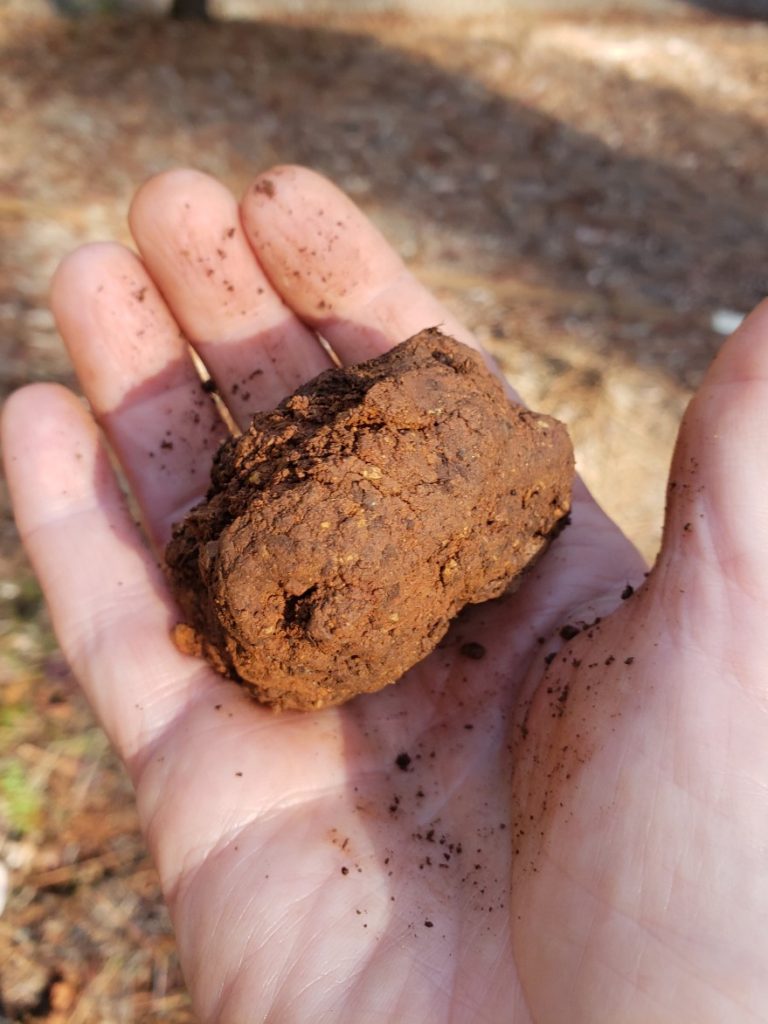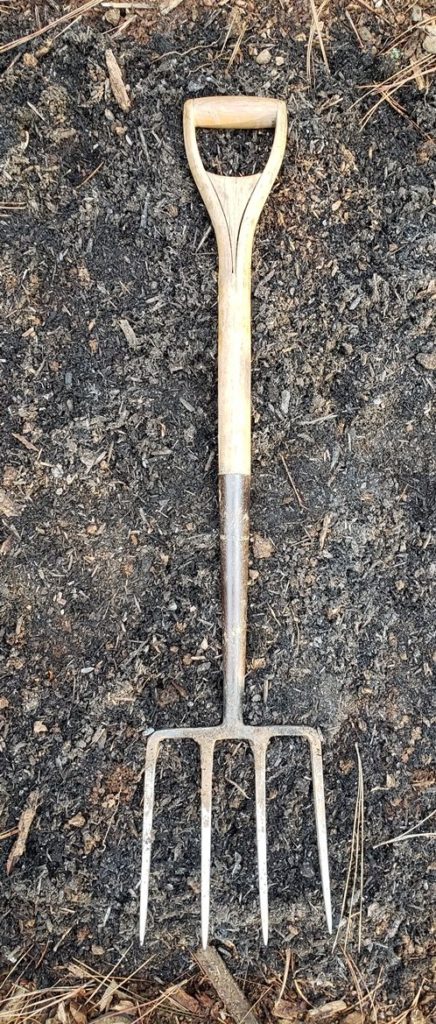Have you been cursing your soil?
Have you tried to plant something this past summer but struggled with rock hard soil?
I hear many complaints about clay soil. People can’t dig into it. When it’s dry, it can be hard as a rock. When wet, it’s sticky and gloopy.
But you can dig into that soil.
By digging when the moisture content is right and using the right tool your gardening can be so much easier and your plants will grow better. Whether you’re digging a hole to plant a shrub or starting a new vegetable bed, if you don’t work your soil at the right moisture level you can damage its structure and that can harm your plants.
And digging at the right time allows you to add amendments and improve your soil’s texture and fertility for happier, healthier plants.
Many of us in Nevada County have clay soil, and that can be a real asset…not a curse.
Oh, the benefits of clay soil!

Clay soil is made up of tiny mineral platelets. These platelets stick tightly together. But water separates them a little which makes the clay soil easier to work with.
These platelets hold water better than other soils. This makes clay a great soil for using less water and for helping plants through drought times.
They hold on to mineral nutrients, which helps with soil fertility. Clay soils have a higher cation exchange capacity, for those who are more technical with their soil. This means less fertilizing is needed.
But clay soils are the most vulnerable to compacting. They can become waterlogged and drain poorly. This happens when working with it when it’s too wet.
How to tell if it’s too wet to dig
You can do the ball test to see if the time is right. Dig some soil and form a tight little ball in your hands. Press your fingers into it. If it stays together it’s too wet. Wait a few days or longer to dig. If it breaks apart and crumbles, it’s ready to dig.
If water drips out of the ball as you form it, it’s way too wet. Or if it won’t stick together to form a ball, then it’s too dry. Wait for more rain or irrigate the soil.
When your soil is very hard in the summer
When you’re working with soil in the summer, the only way to get it moistened is to water it. But it takes a lot of water. Apply it over several days. Too much at once and the water will run off rather than sink in. Dig in to see how deep it has reached. You’ll be surprised at how long and how much water it takes!
I always recommend waiting for winter rains.
Extend your soil moisture with a mulch to work with it later
Apply mulch on the soil, let it sit in the rain, and it will hold soil moisture longer to let you dig it further into the summer. Use aged manure, composts, or any mulch you want to incorporate into your soil. As it rains the good stuff will bring up worms and other soil microbes to boost fertility for you.
You can even top it off with a thick layer of straw. I like oat straw best. I’ve used “spoiled straw” which is straw that’s been left in the rain for at least one winter. It’s partially decomposed and lies down on the bed to stay put through the winter. It protects the compost on your soil and helps rain percolate into the soil. Remove it and add it to a path or compost pile when you’re ready to work that area. This layer adds to moisture conservation in the soil for longer.
Best tool for loosening up the soil

Get a digging fork.
The only tool I have used for loosening soil over many decades is a digging fork. You can pierce the soil and wiggle it in then rock it forward and back to loosen the soil. If it’s really tight push it from side to side. (For most soil prep, that’s all I do because I want to minimize the disturbance of those valuable mycorrhizal fungi in the soil—they help my plants with their nutrient and water needs.)
Mine’s a Bulldog fork made and forged by hand in England. It was one of the original offerings from Smith and Hawken eons ago. Its sharp tines go right into the soil so I can wiggle it in to loosen the soil. Sometimes I have to rock it from side to side to get it in deeper. So far, it has always worked for me. I even use it to loosen soil before shoveling.
Look for a digging fork that your foot fits comfortably on so your foot can push it in and not slide off. And one with sharp tines to slide in easily. Please, always be careful of those tines!!
Another tool to loosen soil deeply, if you need, is a digging bar. It’s a heavy metal bar with a sharp end to loosen deeper into the soil. It’s good for post hole digging.
Dig when it’s easier and you’ll reap many rewards
Being careful of how you work with your soil leads to better soil structure. Good structure takes time to build. It means that the soil allows water in easily, it drains well, it has a good microbe community that feeds your plants, maintains the necessary oxygen in it, and is more drought-resilient.
Digging when the soil is too dry pulverizes the soil making it compacted when it gets wet. Plus it’s near impossible to dig.. Digging when it’s too wet packs the clays together and damages the structure. It can take years to overcome the damage. Even stepping on wet soil compacts it and damages the structure.
Don’t even think you need to use an auger or a drill to loosen dry soil. And don’t chip away at it with a shovel. Water and a digging fork are your very best friends when it comes to digging clay soil. Make use of the rain. But use the moisture test to check if it’s the right time.
Working with your soil at the right moisture level will save you a lot of energy and frustration. Using a digging fork will make it much easier for you, too. You’ll be improving your soil rather than damaging it. That will allow your plants to flourish and make use of the benefits of clay soil.

